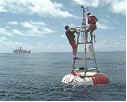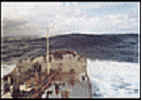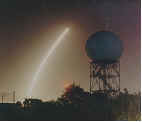 |
Evolution of the GOS  |
Programmes > WWW > GOS > Evolution
(pages updated on
08-Feb-2013
)
Evolution of the Global Observing System (GOS)
The Global Observing System
Since the establishment by WMO of the World Weather Watch (WWW) in 1963, the Global Observing System (GOS) has been the major mechanism for providing continuous and reliable observational data world-wide. The GOS started with a relatively narrow set of observational requirements in support of mainly synoptic, mesoscale and short-term weather forecasts. Over the past four decades, however, the WWW, and specifically its GOS, have drastically developed their technological capabilities in response to requirements that have evolved within WMO and beyond.
 The GOS currently consists of observing facilities deployed on land, at sea, in the air and in outer space. The backbone of the surface-based subsystem continues to be about 11.000 stations on land making observations at or near the Earth's surface, at least every three hours. In addition, nearly 1,300 upper air stations generated over 1500 upper air reports daily. A constellation of geostationary and polar-orbiting satellites constitutes the operational space-based subsystem of the GOS, whose major goal is to augment the observations provided by the surface-based subsystem to achieve complete global coverage. These facilities are owned and operated by the Member countries of WMO, each of which undertakes to meet certain responsibilities in the agreed global scheme so that all can benefit from the consolidated efforts.
The GOS currently consists of observing facilities deployed on land, at sea, in the air and in outer space. The backbone of the surface-based subsystem continues to be about 11.000 stations on land making observations at or near the Earth's surface, at least every three hours. In addition, nearly 1,300 upper air stations generated over 1500 upper air reports daily. A constellation of geostationary and polar-orbiting satellites constitutes the operational space-based subsystem of the GOS, whose major goal is to augment the observations provided by the surface-based subsystem to achieve complete global coverage. These facilities are owned and operated by the Member countries of WMO, each of which undertakes to meet certain responsibilities in the agreed global scheme so that all can benefit from the consolidated efforts.
Requirements for increased long-term reliability and accuracy are being placed upon the GOS by another WMO programme, the Global Climate Observing System (GCOS), a dedicated system designed specifically to meet the scientific requirements for monitoring the climate and its variability.
 |
Although the GOS has been, and still is, the foundation on which all meteorologists depend, there has been gradual but steady erosion of the observing networks during the past few years. At the same time, the emergence of new technologies and techniques has facilitated observations and measurements with greater resolution and accuracy. This, together with greatly increased computing power, has benefited Numerical Weather Prediction immensely by making possible the development of highly sophisticated assimilation techniques that can accept and evaluate observations from any source made at any time. |
| |
|
The Challenge
 The fourteenth WMO Congress, in 2003 reconfirmed the need for a coordinated approach to a fundamental redesign of the GOS. The redesign involved experts and decision-makers in observing technology, network design, and numerical weather prediction (NWP). It addressed innovative ways of funding and operations management for the deployment of observations in remote and/or extraterritorial areas and for developing countries.
The fourteenth WMO Congress, in 2003 reconfirmed the need for a coordinated approach to a fundamental redesign of the GOS. The redesign involved experts and decision-makers in observing technology, network design, and numerical weather prediction (NWP). It addressed innovative ways of funding and operations management for the deployment of observations in remote and/or extraterritorial areas and for developing countries.
The Response
The WMO Commission on Basic Systems (CBS) has made a substantial start on redesign of the GOS and its further evolution. A process named the Rolling Review of Requirements (RRR) has been instituted for continuously reviewing the requirements of WMO Members and international programmes and the results obtained under current circumstances.
 |
Subsequently, CBS formulates and updates system requirements to provide data to meet product requirements and/or goals. From these requirements/goals CBS generates guidance materials for WMO Members, named Statements of Guidance, thus coordinating the needs of the overall Global Observing System. |
The GOS will continue to be the system of operational surface and space-based observing platforms. As a general principal, the evolution of the system will be based on proven techniques and will represent the best mix of observing elements that
- satisfies to the maximum extent the agreed-upon data requirements in respect of accuracy, frequency and spatial resolution;
- is operationally and technically feasible;
- meets the cost-efficiency requirements of Members;
- is reliable and able to meet long-term needs of relevant WMO Programmes and a wide variety of purposes and uses into the first few decades of the 21st century;
- covers ocean and data-sparse areas adequately;
- permits making new technologies available at affordable costs, so that all Member countries can maintain and satisfactorily operate their national components of the system and benefit from them in a sustainable and self reliant manner;
- permits the availability and accessibility of data for operational, research and educational
purposes.
Impact of Evolution
 The impact of the changes to the GOS in the next decades will be so massive that new revolutionary approaches for science, data handling, product development, training, and utilization will be required. The new GOS will facilitate the strengthening of cooperation at national, regional, and global levels among countries and relevant non-Governmental organizations. Finally, as new technologies are introduced, the new system will allow for adequate overlap with the old to enable a smooth transition from the old to the new system, particularly for developing countries.
The impact of the changes to the GOS in the next decades will be so massive that new revolutionary approaches for science, data handling, product development, training, and utilization will be required. The new GOS will facilitate the strengthening of cooperation at national, regional, and global levels among countries and relevant non-Governmental organizations. Finally, as new technologies are introduced, the new system will allow for adequate overlap with the old to enable a smooth transition from the old to the new system, particularly for developing countries.
Vision and Implementation Plan

|
The Vision of the GOS provides high-level goals to guide the evolution of the Global Observing System in the
coming decades. Responding to the Vision of the GOS and WIGOS needs, the Implementation Plan for the Evolution of global observing systems (EGOS-IP) is a key document providing Members with clear and focused guidelines and recommended actions in order to stimulate cost-effective evolution of the observing systems to address in an integrated way the requirements of WMO programmes and co-sponsored programmes.
|